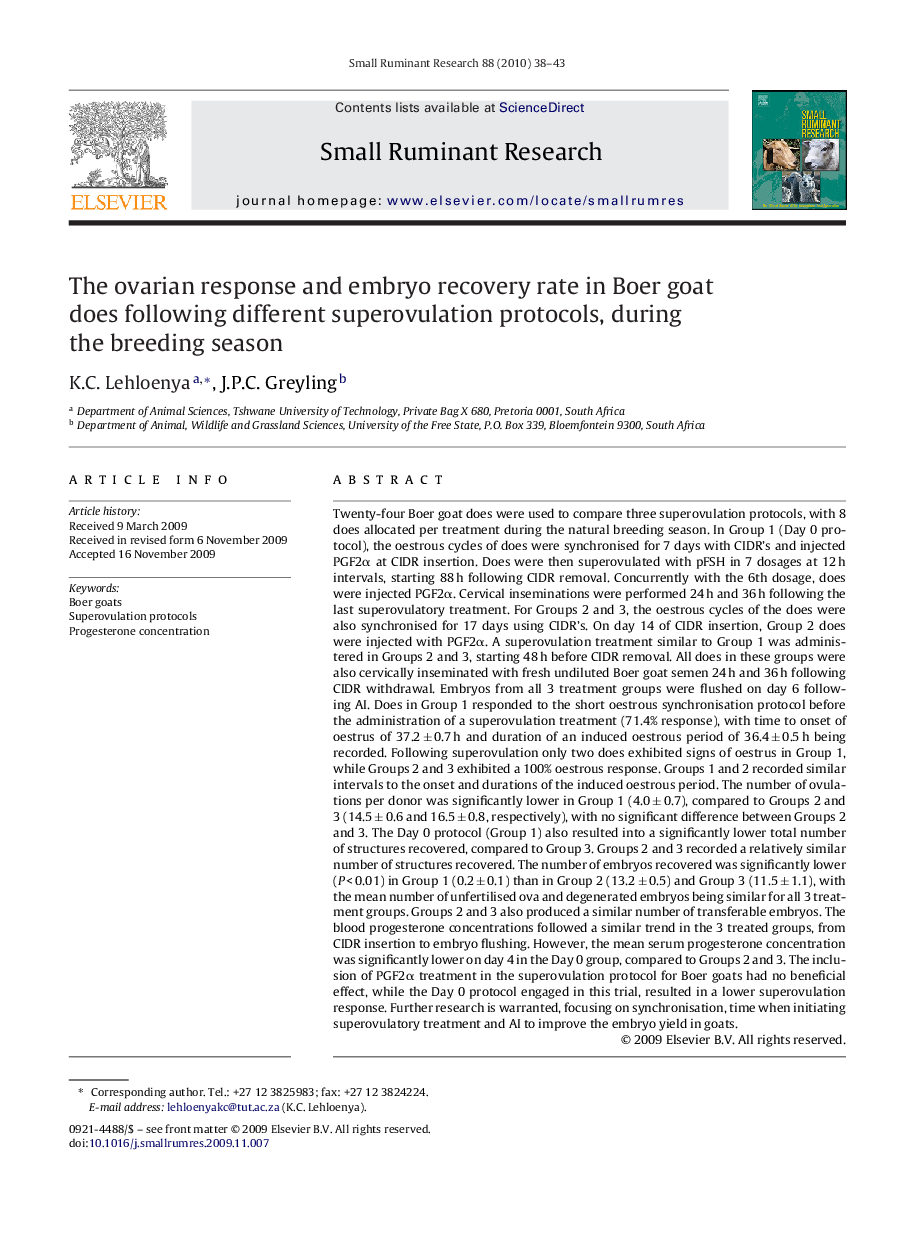| کد مقاله | کد نشریه | سال انتشار | مقاله انگلیسی | نسخه تمام متن |
|---|---|---|---|---|
| 2457704 | 1110726 | 2010 | 6 صفحه PDF | دانلود رایگان |

Twenty-four Boer goat does were used to compare three superovulation protocols, with 8 does allocated per treatment during the natural breeding season. In Group 1 (Day 0 protocol), the oestrous cycles of does were synchronised for 7 days with CIDR's and injected PGF2α at CIDR insertion. Does were then superovulated with pFSH in 7 dosages at 12 h intervals, starting 88 h following CIDR removal. Concurrently with the 6th dosage, does were injected PGF2α. Cervical inseminations were performed 24 h and 36 h following the last superovulatory treatment. For Groups 2 and 3, the oestrous cycles of the does were also synchronised for 17 days using CIDR's. On day 14 of CIDR insertion, Group 2 does were injected with PGF2α. A superovulation treatment similar to Group 1 was administered in Groups 2 and 3, starting 48 h before CIDR removal. All does in these groups were also cervically inseminated with fresh undiluted Boer goat semen 24 h and 36 h following CIDR withdrawal. Embryos from all 3 treatment groups were flushed on day 6 following AI. Does in Group 1 responded to the short oestrous synchronisation protocol before the administration of a superovulation treatment (71.4% response), with time to onset of oestrus of 37.2 ± 0.7 h and duration of an induced oestrous period of 36.4 ± 0.5 h being recorded. Following superovulation only two does exhibited signs of oestrus in Group 1, while Groups 2 and 3 exhibited a 100% oestrous response. Groups 1 and 2 recorded similar intervals to the onset and durations of the induced oestrous period. The number of ovulations per donor was significantly lower in Group 1 (4.0 ± 0.7), compared to Groups 2 and 3 (14.5 ± 0.6 and 16.5 ± 0.8, respectively), with no significant difference between Groups 2 and 3. The Day 0 protocol (Group 1) also resulted into a significantly lower total number of structures recovered, compared to Group 3. Groups 2 and 3 recorded a relatively similar number of structures recovered. The number of embryos recovered was significantly lower (P < 0.01) in Group 1 (0.2 ± 0.1) than in Group 2 (13.2 ± 0.5) and Group 3 (11.5 ± 1.1), with the mean number of unfertilised ova and degenerated embryos being similar for all 3 treatment groups. Groups 2 and 3 also produced a similar number of transferable embryos. The blood progesterone concentrations followed a similar trend in the 3 treated groups, from CIDR insertion to embryo flushing. However, the mean serum progesterone concentration was significantly lower on day 4 in the Day 0 group, compared to Groups 2 and 3. The inclusion of PGF2α treatment in the superovulation protocol for Boer goats had no beneficial effect, while the Day 0 protocol engaged in this trial, resulted in a lower superovulation response. Further research is warranted, focusing on synchronisation, time when initiating superovulatory treatment and AI to improve the embryo yield in goats.
Journal: Small Ruminant Research - Volume 88, Issue 1, January 2010, Pages 38–43